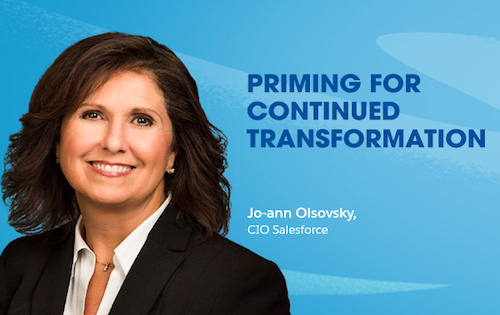When I joined Salesforce in 2018 my challenge, in stepping into the role of CIO, was to support everyday operations and a growing workforce while enabling continual innovation to help drive the business forward.
It’s a challenge that most of us in the role of CIO face. In fact, these days you’re as likely to find CIOs lighting the way and helping their organisations to reach their revenue goals as looking after the day-to-day demands of the IT Department.
The numbers speak for themselves: According to the 2020 State of the CIO report, one in three CIOs are leading change efforts and driving business innovation within their organisations, while 74% said their IT departments are now responsible for cybersecurity, operations, data compliance, and customer experience, in addition to traditional IT areas.
Put another way, it means that when a business is growing at breakneck speed, CIOs and IT departments are tasked with supporting not only the expanding day-to-day operations and a growing workforce but also enabling continual innovation.
Sound familiar? Well, we’ve been there too. So we put together a Playbook for how we use Salesforce technology to scale IT capabilities and drive change across our organisation.
How we positioned Salesforce for the next chapter
Long before I joined Salesforce as CIO in 2018, I was a technician and engineer for AT&T. In those days, IT was thought of like the Managing Information Systems (MIS) department — essentially the backbone of the organisation’s operations but siloed from other business units and widely considered to be a cost centre.
It’s a whole different ball game today.
Nearly half of all respondents to the 2020 State of the CIO survey self-identify as ‘transformational,’ with close to one in three calling themselves a ‘business strategist’ and just one quarter describing their role as purely functional.
A CIO today is a leader, enabling technology-driven change and partnering with the business functional teams to position companies to deliver great products, services, and customer value.
And thanks to the cloud, we no longer have to spend our time on functional activities like cost control and infrastructure issues. Instead, we’re helping to grow the business. That’s why at Salesforce, we rebranded our IT department as Business Technology, which lets everyone know its purpose is to grow the business through technology.
Today, IT is woven into the fabric of the business and it’s part of every function in Salesforce, from employee engagement and recruitment to finance and sales. I like to think of it as the central nervous system helping to drive business outcomes. Not to mention, no matter how well you know your own role, it helps to walk in the shoes of somebody else, which inevitably will surface ideas you might not have otherwise thought of.
Embracing our hybrid world on our digital journey
Customer success is central to Salesforce’s culture and business model — and data is crucial to creating customer relationships that last. If your organisation is anything like ours, you rely on several cloud and on-premises applications and systems, which means that accessing that data quickly and efficiently isn’t always easy.
In fact, MuleSoft’s 2020 Connectivity Benchmark Report found that 85% of organisations admit that integration challenges stall their digital transformation efforts because disparate systems create siloed insights, which affects customer experiences.
MuleSoft is an API company that helps organisations to connect a growing array of business applications and services while unlocking and deriving meaning from valuable data trapped in older systems for use in newer solutions like AI and machine learning.
We’ve been a long-time customer of MuleSoft. We’re a cloud-first company and we use our own products and platform in our business, but we also leverage our partner ecosystem as well as other best-of-breed SaaS vendors. Not only has MuleSoft connected all of our software and data, but it’s also helped us to innovate faster and deliver better outcomes.
That’s why we brought MuleSoft into the Salesforce family in 2018, so we could provide that same capability to our customers.
Salesforce really does run on Salesforce, and we’re excited to share a behind-the-scenes look at how we solve everyday business challenges, improve employee engagement, and boost innovation with the Salesforce Platform.
Download the CIO Playbook today and you’ll see ten ways that we, at Salesforce, are using our own technology to drive our business forward — empowering both our people and our culture.




